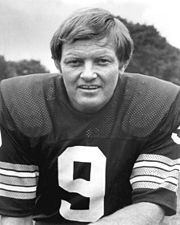
Super Bowl VII was an American football game between the American Football Conference (AFC) champion Miami Dolphins and the National Football Conference (NFC) champion Washington Redskins to decide the National Football League (NFL) champion for the 1972 season. The Dolphins defeated the Redskins by the score of 14–7, winning their first Super Bowl, and became the first and still the only team in modern NFL history to complete a perfect undefeated season. They also remain the only Super Bowl champion to win despite having been shut out in the second half of the game. The game was played on January 14, 1973, at the Los Angeles Memorial Coliseum in Los Angeles, the second time the Super Bowl was played in that city. At kickoff, the temperature was 84 °F (29 °C), making the game the warmest Super Bowl.

Super Bowl XVII was an American football game between the American Football Conference (AFC) champion Miami Dolphins and the National Football Conference (NFC) champion Washington Redskins to decide the National Football League (NFL) champion for the strike-shortened 1982 season. The Redskins defeated the Dolphins, 27–17, to win their first Super Bowl championship. The game was played on January 30, 1983, at the Rose Bowl in Pasadena, California.

Roland Owen McDole is an American former professional football player who was a defensive end in the American Football League (AFL) and National Football League (NFL). He played college football for the Nebraska Cornhuskers.

Darrell Ray Green is an American former professional football player who was a cornerback in the National Football League (NFL) for the Washington Redskins from 1983 to 2002. He is widely considered to be one of the greatest cornerbacks to have ever played in the NFL. Green was inducted into the Pro Football Hall of Fame in 2008.

Samuel Adrian Baugh was an American football player and coach. During his college and professional careers, he most notably played quarterback, but also played as a safety and punter. He played college football for the TCU Horned Frogs, where he was a two time All-American. He then played in the National Football League (NFL) for the Washington Redskins for 16 seasons from 1937 to 1952. After his playing career, he served as a college coach for the Hardin–Simmons Cowboys before coaching professionally for the New York Titans and the Houston Oilers.

Julius Frazier Peppers is an American former professional football player who was a defensive end and linebacker in the National Football League (NFL). He played college football for the North Carolina Tar Heels, where he was recognized as a unanimous All-American, and was selected by the Carolina Panthers second overall in the 2002 NFL draft, and also played for the Chicago Bears from 2010 through 2013 and the Green Bay Packers from 2014 to 2016. After rejoining the Panthers for the 2017 season, he retired after the 2018 NFL season.

Joseph Robert Theismann is an American former professional football player, sports commentator, corporate speaker and restaurateur. He rose to fame playing quarterback in the National Football League (NFL) and Canadian Football League (CFL). Theismann spent 12 seasons with the Washington Redskins, where he was a two-time Pro Bowler and helped the team to consecutive Super Bowl appearances, winning Super Bowl XVII over the Miami Dolphins and losing Super Bowl XVIII. He played college football for the Notre Dame Fighting Irish and was inducted into the College Football Hall of Fame in 2003.

Lawrence Brown Jr. is an American former professional football player in the National Football League (NFL) who played running back for the Washington Redskins from 1969 to 1976.
The National Football League playoffs for the 1974 season began on December 21, 1974. The postseason tournament concluded with the Pittsburgh Steelers defeating the Minnesota Vikings in Super Bowl IX, 16–6, on January 12, 1975, at Tulane Stadium in New Orleans, Louisiana.
Wilber Buddyhia Marshall is an American former professional football player who was a linebacker in the National Football League (NFL) for five teams from 1984 until 1995. Marshall played college football for the Florida Gators, was twice recognized as a consensus All-American, and is a member of the College Football Hall of Fame.
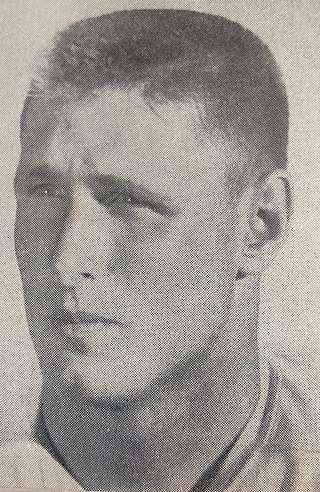
William Orland Kilmer Jr. is an American former professional football player who was a quarterback in the National Football League (NFL) for the San Francisco 49ers, New Orleans Saints, and Washington Redskins. He was also used as a running back and wide receiver. He played college football for the UCLA Bruins, then 18 seasons as a professional. In 1964, while playing running back for the 49ers, Kilmer played a supporting role in one of the most infamous incidents in gridiron history when Vikings defensive lineman Jim Marshall ran Kilmer's fumble back 66 yards into the wrong end zone.
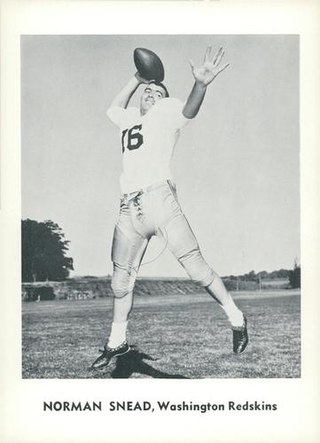
Norman Bailey Snead was an American professional football player who was a quarterback in the National Football League (NFL). He played for the Washington Redskins, Philadelphia Eagles, Minnesota Vikings, New York Giants, and San Francisco 49ers. He played college football for the Wake Forest Demon Deacons and was selected in the first round of the 1961 NFL Draft with the second overall pick.
The Commanders–Cowboys rivalry is a National Football League (NFL) rivalry between the Washington Commanders, formerly known as the Redskins, and the Dallas Cowboys. In 2005, Sports Illustrated called it the top NFL rivalry of all time and "one of the greatest in sports." ESPN ranked it the best rivalry in the NFL. The Sportster has ranked it the 17th biggest rivalry in the world. During the tenure of this rivalry, the two franchises have won 32 combined division titles and eight combined Super Bowls. They are two of the wealthiest franchises in the NFL. The rivalry started in 1960 when the Cowboys joined the league as an expansion team. During that year they were in separate conferences, but played once during the season. In 1961, Dallas was placed in the same division as Washington, and from that point on, they have played each other twice in every regular season.

Ulmo Shannon "Sonny" Randle Jr. was an American sportscaster and football player and coach. He played wide receiver in the National Football League (NFL) for the Chicago Cardinals/St. Louis Cardinals, San Francisco 49ers and Dallas Cowboys. Randle played college football at the University of Virginia.

The Washington Redskins are a professional American football franchise based in the Washington metropolitan area. They are members of the East division in the National Football Conference (NFC) of the National Football League (NFL). The Commanders were founded in 1932 as the Boston Braves, named after the local baseball franchise. The franchise changed its name the following year to the Redskins and moved to Washington, D.C. in 1937. In 2020, the team retired the Redskins name after longstanding controversies surrounding it and briefly became the Washington Football Team, before choosing the Washington Commanders as their permanent name in 2022.

Isiah "Butch" Robertson was an American professional football player who was a linebacker for the Los Angeles Rams (1971–1978) and the Buffalo Bills (1979–1982). He was selected to six Pro Bowls during his years with the Rams. He had 25 career interceptions, returning three for touchdowns, scoring a fourth touchdown on a fumble recovery in 1978. According to Rams and Bills records, Robertson also sacked the quarterback 24+1⁄2 times and forced 16 fumbles in his career.
George William Izo was an American professional football player who was a quarterback for seven seasons in the National Football League (NFL). He played for the St. Louis Cardinals, Washington Redskins, Detroit Lions, and the Pittsburgh Steelers from 1960 to 1966, having earlier played college football at the University of Notre Dame.
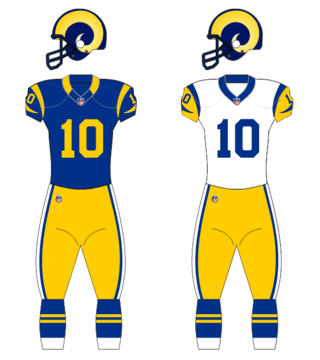
The 1977 Los Angeles Rams season was the team's 40th year with the National Football League and the 32nd season in Los Angeles.
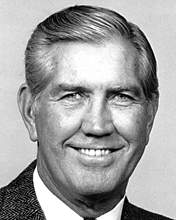
Lewis Glen Carpenter was an American football player and coach. He played college football for the University of Arkansas and professionally for ten seasons in the National Football League (NFL) as a halfback and fullback with the Detroit Lions, Cleveland Browns, and Green Bay Packers. He played on three NFL Championship teams, with Detroit in 1953 and with Green Bay in 1961 and 1962. After his playing career ended, Carpenter spent 31 years as an assistant coach in the NFL with the Minnesota Vikings (1964–1966), Atlanta Falcons (1967–1968), Washington Redskins (1969), St. Louis Cardinals (1970–1972), Houston Oilers (1970–1974), Green Bay Packers (1975–1985), Detroit Lions (1987–1988), and Philadelphia Eagles (1990–1994). Carpenter also coached the Frankfurt Galaxy of the World League of American Football in 1996 and at Southwest Texas State University. He concluded his 47 years of playing and coaching football at the end of the 1996 season. Scientific tests on his brain diagnosed post-mortem that he had an advanced case of chronic traumatic encephalopathy (CTE).
The 1977 Washington Redskins season was the franchise's 46th season overall, and would be the last under Hall of Fame head coach George Allen. The season began with the team trying to improve on their 10–4 record from 1976, but they would finish 9-5 and fail to qualify for postseason play.

